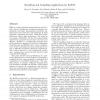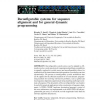958 search results - page 135 / 192 » Using the UML for Architectural Description |
FCCM
1998
IEEE
14 years 1 months ago
1998
IEEE
E cient, deeply pipelined implementations exist for a wide variety of important computation-intensive applications, and many special-purpose hardware machines have been built that...
WOB
2004
13 years 10 months ago
2004
ABSTRACT. Reconfigurable systolic arrays can be adapted to efficiently resolve a wide spectrum of computational problems; parallelism is naturally explored in systolic arrays and r...
LOGCOM
1998
13 years 8 months ago
1998
Perhaps the most successful agent architectures, and certainly the best known, are those based on the Belief-Desire-Intention (BDI) framework. Despite the wealth of research that ...
ER
2007
Springer
14 years 3 months ago
2007
Springer
There are a number of issues for information systems which are required to collect data urgently that are not well accommodated by current conceptual modelling methodologies and a...
POPL
2000
ACM
14 years 14 days ago
2000
ACM
with existing analysis tools. Modular reasoning principles such as abstraction, compositional refinement, and assume-guarantee reasoning are well understood for architectural hiera...


